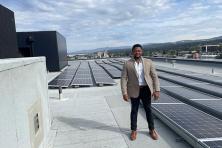While eating lunch and looking through news headlines recently, I had to pause as I saw this New York Times piece: “U.N. Says Lag in Confronting Climate Woes Will Be Costly.”
And then last night these words from President Obama: “our job is to reverse these trends.” The newest draft report from the United Nations is another sobering reminder about the massive economic and environmental impacts we are already facing, and the unthinkably grave consequences to come if we do not act swiftly and decisively.
Maybe like you, I’ve been feeling an intense mix of emotions of late about our ability to confront the climate challenge with the urgency and ambition required. On the one hand, the science news is relentlessly sobering. It’s late, and we have so far to go. On the other hand, the momentum for solutions is building, and the climate movement is growing strong.
What’s feeding this optimism?
1. The West Coast edge
We have the opportunity to put in place the most ambitious set of integrated climate policies in the nation, stretching from California to British Columbia. Combined, our region is the fifth largest economy on the planet. This region has what it takes to end the era of free and unlimited carbon-dumping, and engineer a steady and sweeping transition to clean power and transportation. Working closely with these forward-leaning states, and with incredible allies such as the Washington Environmental Council, Oregon Environmental Council, and Sightline Institute, we do this.
If successful, we will cut carbon pollution in our region while building the business, policy, and program models that catalyze national and international action. Over the course of the next three years, this coordinated push for West Coast climate leadership is Climate Solutions’ top objective.
2. Solutions to the climate crisis
Every day, in our communities and across the globe, comes more impressive news about clean energy technology, financial innovation, and on-the-ground deployment. Last week, Spain announced wind was the single largest electricity source for the entire nation, providing over 20% of the country’s power. The cost of solar panels has decreased by 60% since 2011 while the amount of installed solar in the United States doubled in 2012. Energy efficiency continues to play its quiet yet powerful role in controlling costs, delivering jobs, and cutting climate pollution. In the transportation sector, convenient alternatives to oil dependence, from electric cars to bike-sharing, are more available and affordable every time I look. The clean energy revolution is on.
We will continue to prioritize the need to demonstrate and celebrate solutions in our region. Through our strategic innovation programs like New Energy Cities, Sustainable Advanced Fuels, and the Northwest Biocarbon Initiative, we are partnering with major businesses, cities, farmers, and foresters to cut emissions and store carbon throughout the Northwest. And that’s just a small slice of the emerging transition. Our Solutions Story Project is profiling success and building confidence in the clean energy economy as a viable, attractive way to deliver broadly shared opportunity and prosperity. “Climate solutions” means a lot more than our organization; it’s a huge story, and it needs to be told!
3. Powering past coal
Across the United States, coal, the single largest source of climate pollution, continues to decline in use. The Northwest is on the front lines of this transition, phasing out our own coal plants and refusing to serve as staging ground for coal exports. The physics are not subtle: the coal era must end, and the Northwest can show the way by becoming the first coal-free, clean energy-powered region. This transition presents an unprecedented opportunity for investment and deployment in clean energy sources and efficient energy use – a main driver for Northwest prosperity.
The Northwest will be the point of departure from the fossil-fueled past, and the proof point for the clean energy future. The coalition campaign to Power Past Coal is a daily source of inspiration. And it just keeps growing stronger.
4. National action
Looking beyond our Northwest borders, it’s encouraging to see the Obama administration begin to reduce climate pollution from the biggest source – coal-fired power plants. Along with historic fuel economy improvements – catalyzed by state leadership on clean car standards – the administration is forging ahead in some key areas. The oil and coal companies’ political stranglehold on Congress has blocked the legislative path, but the president is moving forward. Sustaining that progress and winning strong rules on climate pollution from power plants will be an epic fight. Meanwhile, the Keystone XL pipeline – once considered by beltway insiders to be a “lost cause” – is a continuing battle and a testament to growing power of the grassroots movement for climate action. The president’s high-profile pledge to make climate impact a determining factor is a huge step forward toward climate reality.
This isn’t theoretical anymore; climate consequences are upon us. It isn’t too late for bold action, but it sure as heck isn’t too early!




